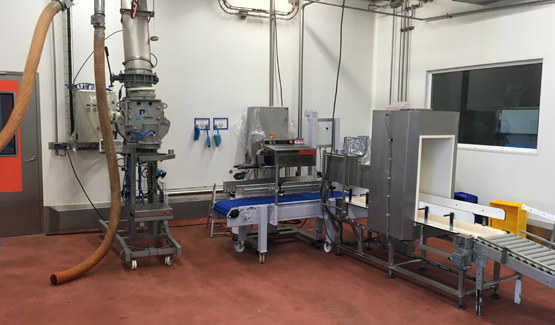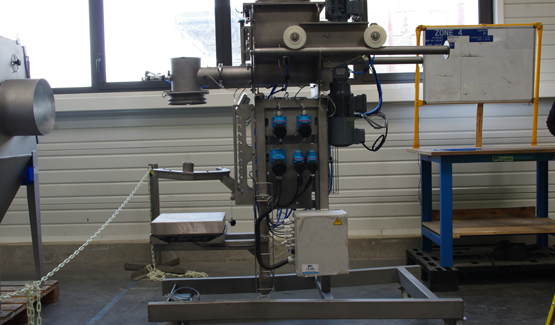Processed powder: spice mixture with an apparent density of 500 kg/m³
Objective: Controlled dosing of spices
The company supplies spices and flavorings to professionals in the delicatessens, catering and instant ready meals industries.
The customer needed to upgrade his manual dosing system with a loss-in-weight metering device to fill 5 to 25 kg bags and 10-to-27-liter buckets, at a rate of 1.5 tons per hour. The entire dosing system must be mounted on a mobile frame to allow cleaning in their washing room.
The raw materials pass through a vibrating screener which provides quality control by removing foreign bodies and agglomerates from industrial production lines involving raw ingredients and bulk materials handling. To guarantee current hygienic standards in the food industry, a magnetic detection system is installed at the outlet of the vibrating screen to retain ferrous metal particles. The bars, positioned inside the bulk material flow, retain metal particles to provide protection of machines and systems in the production line.
The bulk material passes through a drop chute, which is connected to an industrial dust collection pipe, and into a D13 screw dispenser connected by a flexible connector with an integrated discharge shaft. A butterfly valve is positioned between the pipe and the flexible connector to control the flow of bulk materials. The dosing unit allows batch or continuous metering via volumetric or weight means. The parts in direct contact with the material are made of 316 L stainless steel, while the non-contact parts are made of 304 L stainless steel. The D13 metering device provides a uniform, progressive and controlled flow of the spice mixture out of the buffer hopper. For this application, the system achieves a flow rate of 6,458 liters per hour.
The screw feeder is installed on a complete packing system (filling head and weigh scale), called "PalSack® 01 Filling Machine" equipped with a mobile frame that facilitates necessary cleaning procedures. It can fill 1.5 tons per hour with an accuracy of 150 grams.


Bag conditioner
The operator positions the bag or pouch around the inflatable seal of the filling head. By means of a pneumatic pedal, it allows the seal to be inflated, which creates the tightness. The upstream dosing device fills the bag. The PLC is equipped with a "high" and "low" speed system in order to adjust the dosing accuracy as precisely as possible. The volumes are balanced via the double jacketed filling tube. Depending on the size of the bag, the operator positions the appropriate filling head. The head is placed using clamps and flanges.
Bucket conditioning
The operator disconnects the bag filling head and the flexible connector to position the bucket filling head. It is equipped with a vacuum system and does not touch the bucket at any time. A blocking stop is also provided to allow the rapid positioning of the bucket. The operator positions the bucket under the head and authorizes filling. The filling of the bucket can begin.
For both configurations, whether for bags or buckets, a dedusting ring is manually positioned at the vertical outlet of the D13 metering device. This metering device collects the dust generated during the filling process and is connected to the industrial dust collection system. It is adjustable according to the height of the different bags and buckets.
Once the bags or buckets have been filled, the mechanized roller conveyors take them to a bag welding machine and labeling machines.


















